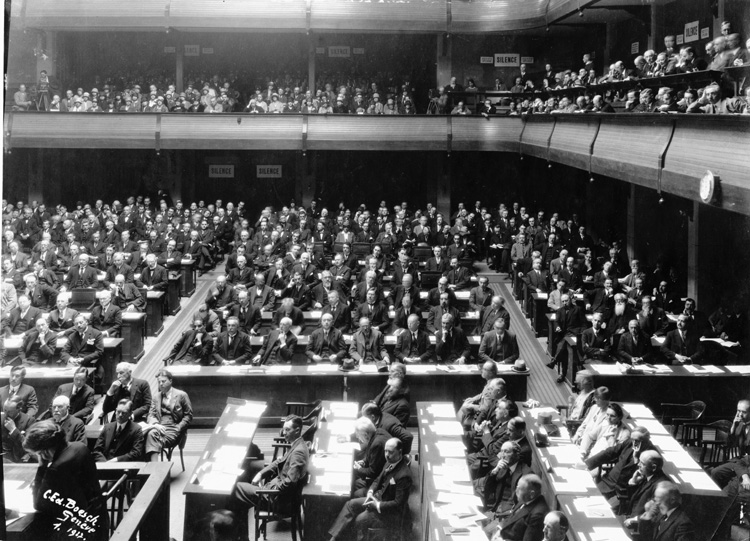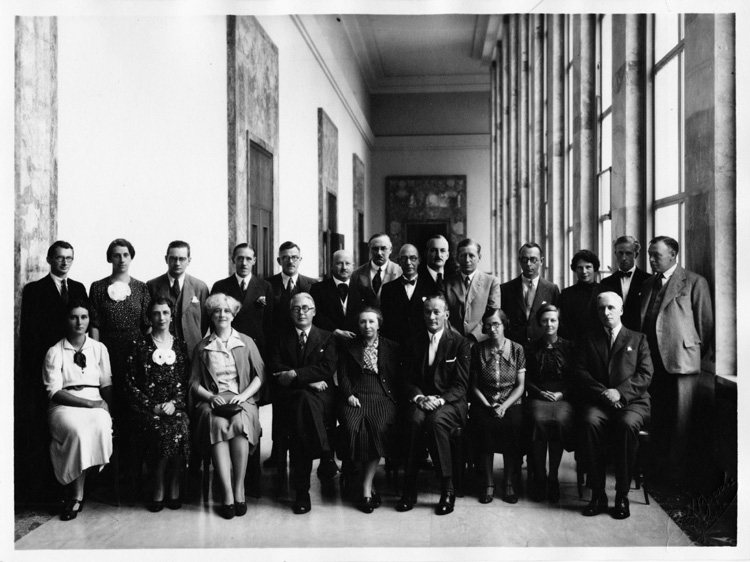An international language: The Translation and Interpretation Service
Haakon A. Ikonomou (postdoc - Aarhus University)
“I wonder if you could tell me the meaning of an obscure Finnish word I’ve got here? I think it’s perhaps something to do with fishing tackle”, goes one of the lines in a fantastic information movie called “The League at Work”, produced by the League itself in 1935. The movie, introducing the viewers to all the aspects of the Secretariat, gives the Translation and Interpretation Service a rather prominent place as the first in line. And no wonder: for it was one of the peculiar procurements of the Secretariat – indeed, one of the features that made it international in all its doings.
So much to do!
The Interpreters and Translators Service was created because the League of Nations employed two official languages – French and English. “As the business of the League will be conducted in the French and English languages”, Secretary-General Eric Drummond made clear upon the organisation’s creation, “it is essential for the efficiency of the organisation that the members of the ‘material’ side of the organisation should be drawn from French and English speaking nations”.1 And, so it was. From June to October 1919 a single Service was set up with a small number of French and English translators and interpreters, under the direction of the Swiss Dr. Parodi (yes!).
The Service soon divided into two distinct sub-sections – interpreters (oral) and translators (written), respectively – and the original five employees were joined by new staff in the course of 1920. The division between interpretation and translation was done after the first Assembly in the late fall of 1920. Translators and interpreters did very different things, the Secretariat discovered, and the translation sub-section was strengthened with two chief translators, ensuring that all official and public documents produced by the Assembly, Council or Secretariat were of the best quality possible.
With the expansion of the Secretariat and the move from the temporary seat in London to the permanent seat in Geneva, the workload, unsurprisingly, grew explosively. In the two last months of 1919, the Service worked with 300 documents, in all of 1920 they handled 2200 documents, the three first months of 1921 they had already had their hands on 1200 documents. This development required a slight expansion of the Service, and by early 1921, it consisted of one Director, two Chief Translators, fourteen translators, four Interpreters and two Assistant Secretaries. Its workload would, however, continue to grow: In 1928, the Eight Assembly reported that the amount of translation had doubled and the amount of verbal interpreting had increased about five times, since 1921.2
The Service dealt with almost all written material and all speeches produced in Geneva. The translators not only worked with documents drawn up by the various sections of the Secretariat, but also communications of every kind received by the League of Nations. The interpreters, on their part, worked in a rather spasmodic fashion, having loads to do in connection with Assemblies, Conferences and meetings of Commissions or Committees. Between such events, they would help out the translators. Both sub-sections had to deal with a wide range of languages, having to master French and English fluently, while covering most other Member State languages through employees covering regions or language groups (German, Spanish, Nordic languages, Slavic languages etc.).

The Eighth Assembly of the League of Nations (1927) – During the hectic Assemblies the entire Service, and additional hired help, worked day and night to ensure that things ran smoothly.
The rhythm of Geneva, the fact that work was created by events entirely out of their hands, meant that the interpreters and translators worked strange and long hours. As the Director reported in 1921, it often “called for great devotion to duty on the part of its members; during Conferences (…) and during the Assembly night work was always necessary”. The unique environment and tasks in Geneva also meant that the Service acquired, with time, a distinct way of doing things – making the multilingual organisation hum as if it only had one.3
Towards a Geneva language
Being a translator for the League required a thorough knowledge of general political questions, but it also required an equal feel for complicated technical subjects. As one of the first League chroniclers, Howard-Ellis, writes, by 1928 the Eight Assembly estimated that about three-quarters of all the translation work was “highly technical”. Their work involved “specialized knowledge of such subjects as medicine, serology, epidemiology, transport, military and naval matters, aviation, economics, chemistry, public finance, international and commercial law”.4 Accordingly, the translation and interpretation service developed highly-specialized language skills. Moreover, due to the less proficient national administration in writing up official texts in English or French, the translators preferred to receive material in the original language – translating themselves from the native tongue.
With time, therefore, the Service created a lingua franca suited to the technical terminology of the League, smooth translation from French to English (or vice versa), and taking diplomatic tact into consideration. As Ranshofen-Wertheimer notes:
“Out of trial and error grew slowly a terminology and technical language which gave League documents that special style so often criticized by language purists who were unaware of the difficulties involved. This terminology and style may have been involved and may have smacked of bureaucratic pedantry but its adoption was the only way out of difficulties which otherwise would have been quite insurmountable”.5
This Geneva language was, one could say, constructed for the League to function as the optimal instrument of understanding between the different Member States, even if it meant having to forego Oxford English for something more mundane.

The translation and interpretation service – date unknown
Translation and Interpretation as Heroic Internationalism
In this way, the translators and interpreters – one of the peculiarities of the internal administrative services that set them apart from national public administrations – and their development of a distinctly international bureaucratic language, was something that facilitated equality of terms and understanding. It was, as former staff members would maintain, the international language of the League, and thus also a crucial part of the diplomatic function of the League as a political arena.
For die-hard internationalists like Ranshofen-Wertheimer, a former member of the Information Section of the League, the Translation and Interpreting Service symbolised the purest form of internationalism. The degree of coordination, he mused in his book on the Secretariat, was “reflected in the clockwork precision with which documents were supplied (…) one of the glories of the Geneva administration”, indeed, “one of the most efficient administrations the world has ever seen”.6
This internationalism went beyond the bureaucratic set-up of the Service: “In the final count it was the human element (…) not the administrative patterns and techniques, which accounted for the efficiency with which the technical tasks were dispatched,” he concludes one of his chapters, “a staff whose high skill and readiness to work at all hours of the day and the night presented to the outside world a picture of flawless teamwork. (…) The routine and traditions established in the first years triumphed over all the obstacles – those coming from outside as well as those created by developments within the administration.”7
The nostalgia of those first-generation chroniclers of the League experiment, often writing during the Second World War, tended to enhance the heroic internationalism, indeed martyrdom, of the Secretariat, defying the cruelties of the world to the very end. Consider this story, recalled by Ranshofen-Wertheimer:
“This writer remembers many instances in which interpreters performed seemingly impossible feats. Sir John Simon once put the French interpreter deliberately to a dramatic test during the involved deliberations of the Disarmament Conference. He concluded a long and difficult speech with a quotation from Shelley, obviously to challenge the skill of the French interpreter, Monsieur M. The latter interpreted the speech as usual with hardly any recourse to notes, as was his habit, and, incidentally, the habit of nearly all top interpreters. To the amazement of the listeners he rendered the Shelley quotation in French verse, thus reaching a peak which will never be surpassed in the history of this art. (…)”8
The choice of Sir John Simon as the nemesis cannot have been coincidental. He was, after all, known for his lack of love for the League method of solving international problems. In this tale, therefore, the bureaucrat of the Secretariat is the true internationalist – as he would be in many memoirs and histories produced by former League staff.
Strange that such grandiose feats could come from such tedious tasks as translating a Finnish word describing fishing tackle.
References
1) League of Nations Archives (LONA), Geneva - R 1455 – Draft Resolution for submission to the Organisation Committee, at meeting to be held in July. (July 9, 1919).
2) C. Howard-Ellis The Origin, Structure and Working of the League of Nations (London: George Allen & Unwin, 1928), p. 193.
3) This section builds extensively on: LONA, Geneva - C.E./1-27 – 1921 – Report on the Organisation, Work, and Personnel of the Interpreters and Translators Section.
4) Howard-Ellis, p. 193.
5) Egon F. Ranshofen-Wertheimer The International Secretariat. A Great Experiment in International Administration (Washington: Carnegie Endowment for International Peace, 1945), p. 139.
6) Ranshofen-Wertheimer, p. 150-151.
7) Ranshofen-Wertheimer, p. 151.
8) Ranshofen-Wertheimer, p. 140-141.
All pictures are from the League of Nations Photo Archive (Indiana University):
www.indiana.edu/~league/photos.htm
